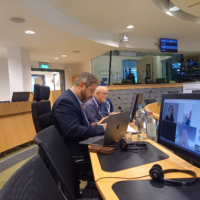Cross-border monitoring in functional urban areas – the workshop of the Eurostat
Border studies + Knowledge sharing | 01 July 2024
Border studies + Knowledge sharing | 01 July 2024
The Eurostat has been assigned by the European Commission to define the indicators for monitoring the cross-border functional urban areas. The first results of the project were presented within a workshop of professionals in Brussels on 20 and 21 June, 2024.
The workshop titled ’Roundtable on cross-border city statistics’ was coordinated by Oliver Heiden and Alexandra Galić, the two commissioned experts of the Eurostat who summarised their mission and presented the methodological background of the evaluation. When defining cross-border functional urban areas (FUA) they followed the generally accepted definition of FUAs based on population density and the 15% ratio of the commuters within the urban influencing zone. Based on these factors, they found 11 cross-border FUAs within the EU, however, numerous further ones could be included in the investigations.
The invited experts representing the Federal Office for Building and Regional Planning (BBSR) from Germany, the National Statistical Office (INSÉE) of France, the Organisation of Economic Cooperation and Development (OECD), the Association of European Border Regions (AEBR), the Mission Opérationnelle Transfrontalière (MOT) and CESCI, as well as the representatives of selected PILOT areas (the twin cities of Kerkrade and Herzogenrath (NL/DE), the Basque Euroregion (FR/ES), the trinational eurodistrict of Basel (CH/FR/DE) and the city of Aachen (NL/DE)) were given the opportunity to comment on the methodology and the results of the project and to present their own achievements and experiences related to the topic. Further participants joined online representing the Dutch National Statistical Office, the Joint Research Centre (JRC) which is developing a new comprehensive platform presenting different forms and fields of cross-border cooperation within the EU, the twin cities of Frankfurt and Słubice (DE/PL), etc. who also could contribute to the discussion.
As a result of the workshop, it became clear that the traditional definition of the FUA cannot entirely be adapted to the cross-border realities. The concept of the cross-border living areas (bassins de vie) developed by the MOT seems to be more adaptable but it lacks the regulative background that the definition of FUAs owns. As Ricardo Ferreira (DG REGIO) highlighted, the narrowed-down definition might generate the mis-interpretation that the issue of cross-border FUAs is neglectable; however, large cross-border urban agglomerations produce lively cross-border mobility phenomena. Through his presentation Gyula Ocskay, secretary general of CESCI pointed at the shortcomings and incompatibilities of local level data harmonisation and mentioned a few alternative methods to measure cross-border flows and mobility which, according to him, should be the real objective of statistical research.
To conclude the workshop, the organisers stipulated the need for a permanent platform of exchanges designed to the twin cities, national statistical offices and professional bodies; the definition of data needs; the elaboration of an action plan sketching future steps to be taken; and the promotion of the initiative in order to ensure a larger visibility both for the project and the cross-border functional urban areas.
